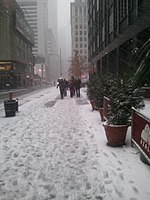Turtle Bay Gardens Historic District
Historic districts in ManhattanHistoric districts on the National Register of Historic Places in ManhattanNew York City Designated Landmarks in ManhattanNew York City designated historic districtsTurtle Bay, Manhattan ... and 1 more
Use mdy dates from May 2021

The Turtle Bay Gardens Historic District is a collection of twenty rowhouses in the Turtle Bay neighborhood of Manhattan in New York City. They consist of eleven houses on the south side of 49th Street and nine on the north side of 48th Street, between Second and Third Avenues.: 3–4 The rowhouses, dating from the 1860s, were renovated between 1918 and 1920 by Charlotte Hunnewell Sorchan to plans by Clarence Dean.The New York City Landmarks Preservation Commission designated the Turtle Bay Gardens Historic District in 1966, and it was listed on the National Register of Historic Places in 1983.
Excerpt from the Wikipedia article Turtle Bay Gardens Historic District (License: CC BY-SA 3.0, Authors, Images).Turtle Bay Gardens Historic District
East 48th Street, New York Manhattan
Geographical coordinates (GPS) Address Nearby Places Show on map
Geographical coordinates (GPS)
| Latitude | Longitude |
|---|---|
| N 40.754166666667 ° | E -73.970277777778 ° |
Address
East 48th Street 235
10017 New York, Manhattan
New York, United States
Open on Google Maps






